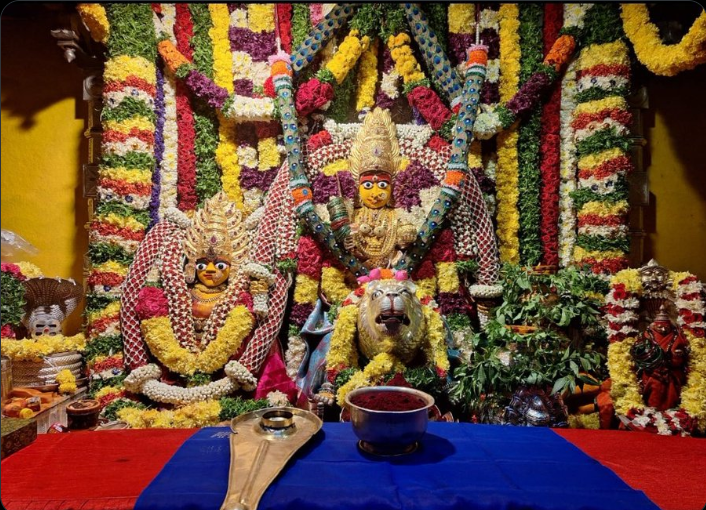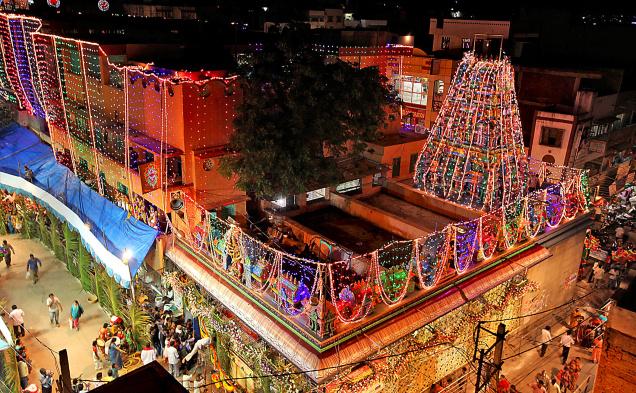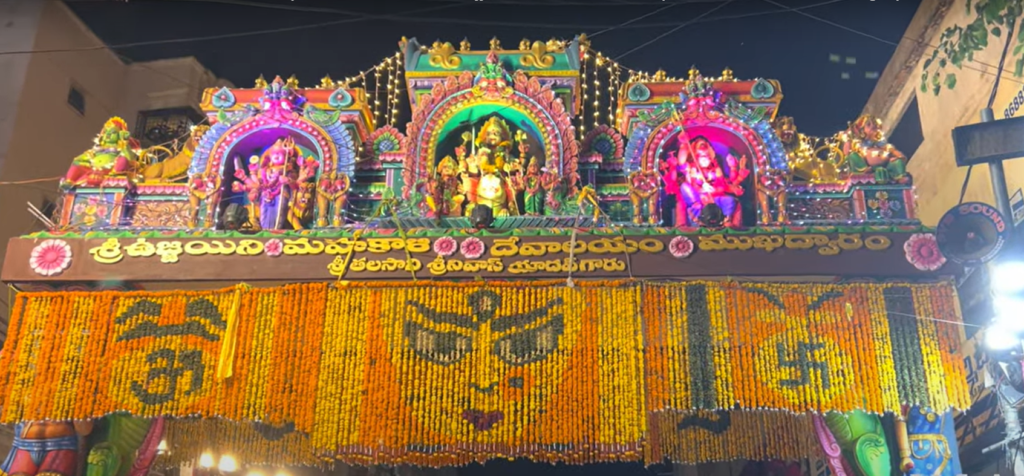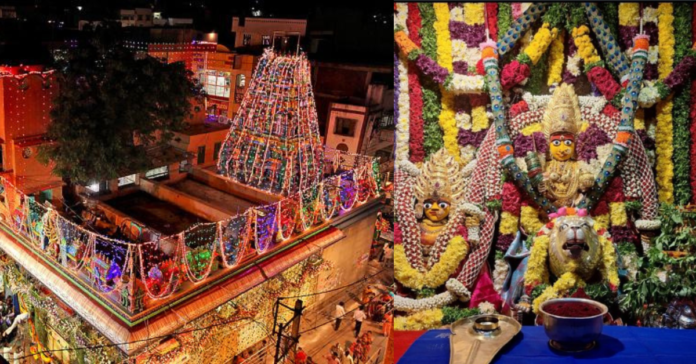Introduction:
In 1813, a military battalion, including Suriti Appaiah, a Doli Bearer, was transferred to Ujjain. During this period, a severe cholera outbreak claimed thousands of lives. Suriti Appaiah and his associates prayed at the Mahakali Devasthanam, vowing to install an idol of Mahakali in Secunderabad if the epidemic subsided. Upon their return, they installed a wooden idol of Goddess Mahakali in Secunderabad in July 1815. During the construction of the sanctum sanctorum, a stone idol named Manikyalamma was discovered and installed beside Ujjaini Mahakali Temple in Hyderabad Ammavaru.

History and Significance
Initial Establishment
Year: 1815
Founder: Suriti Appaiah
Initial Idol: Wooden idol of Goddess Mahakali
Significant Discovery: The stone idol of Manikyalamma during construction
In 1964, a stone idol of Goddess Mahakali replaced the wooden one. Suriti Appaiah, with the support of philanthropists, developed the Ujjaini Mahakali Temple in Hydarabad which later came under the administration of the Endowments Department. The founder’s great-grandson, Suriti Krishna, actively participates in the temple’s management.
The Ujjaini Mahakali Devasthanam is recognized under Act 30 of 1987 and is administratively controlled by the Commissioner of the Endowments Department, Hyderabad. Philanthropic devotees like Ammanabolu Nagabhushanam have contributed to the temple’s development, including the construction of a Kalyana Mandapam and a Rudraksha Mandapam made of silver.
Also Read: Jagannath Temple Hyderabad: Timings, address, Ticket Prices And Photos
Development Over the Years
1964: Installation of a stone idol of Goddess Mahakali, replacing the wooden one
Philanthropic Contributions: Development aided by donations from devotees and philanthropists
Management: Taken over by the Endowments Department with the involvement of Suriti Appaiah’s descendants

The temple, established 191 years ago, is a significant spiritual site in the Telangana region. Devotees flock daily and in large numbers during the Ashada Jathara, held on Sundays and Mondays, seeking blessings and fulfilling vows.
The stone idol of Goddess Ujjain Mahakali, seated in a Padmasana posture with four hands holding a sword, spear, damaru, and a vessel of amrut, is a sight to behold. The idol, believed to have been brought from Ujjain, is adorned with a silver shield and accompanied by the deity Manikyaladevi.
Despite the lack of historical records, the temple stands as a testament to Suriti Appaiah’s devotion, akin to the Shri Rama temple at Bhadrachalam. Suriti Appaiah, a military mason in 1813, became a devout follower of Mahakali at Ujjain, vowing to install her idol in Ujjaini Mahakali Temple in Hyderabad
In July 1815, Suriti Appaiah installed the wooden idol at the temple’s current location. The temple grounds, once overrun by nature, revealed the idol of Manikyalamma during well repairs, which was then installed beside Mahakali. In 1864, the wooden idol was replaced with stone idols of Mahakali and Manikyalamma, following Hindu rituals.

Key Contributions:
Structural Enhancements
Kalyana Mandapam: Constructed by Ammanabolu Nagabhushanam
Rudraksha Mandapam: Made of silver, added to Garbhalayam
Ornamental Silver Sheets: Adorning the Garbhalaya Dwaram
Family Contributions:
Sanctum and Mandapam: Constructed by Suriti Appaiah and his descendants
Shops: Built for income generation
Committee Formation: Established to conduct daily rituals and manage the temple
Subsequent generations of Suriti Appaiah’s family continued to develop the temple. His son, Sanjivaiah, and grandson, Laxmaiah, constructed a mandapam and shops for temple income. In 1914, Laxmaiah’s son, Kistaiah, formed a committee to conduct daily pujas and archanas, appointing a Brahman for rituals. The endowment department took over in 1947, continuing the legacy of devotion and development.
Also Read: The Birla Mandir Hyderabad: One of the Iconic temples
Festivals and Rituals:
Ashada Jathara:
When: Annual festival during the month of Ashada
Significance: Attracts thousands of devotees
Special Days: Principal days are Sunday and Monday
Daily Rituals
Pujas and Archanas: Conducted daily by appointed Brahmins
Sodasochar Puja: A special ritual performed every Friday
Temple Management:
Historical Management
Founder’s Family: Suriti Appaiah and his descendants played a key role in early management
Endowments Department: Took over management in 1947
Committee Formation: Included family members and local community leaders
Current Management:
Administrative Control: Ujjaini Mahakali Temple in Hyderabad Under the Commissioner of the Endowments Department, Hyderabad
Philanthropic Involvement: Continuous support from devotees for development
Managed by the Endowments Department and supported by the community, theUjjaini Mahakali Temple in Hyderabad Devasthanam remains a vital part of Secunderabad’s spiritual landscape. It reflects the enduring legacy of Suriti Appaiah’s devotion and the continued efforts of his family and the local community to preserve and enhance this sacred site. As the temple continues to thrive, it stands as a reminder of the power of faith, community, and tradition in shaping cultural heritage.
Architectural Features:
Main Idols
Goddess Mahakali: Stone idol seated in Padmasana posture with four hands
Manikyalamma: Stone idol installed beside Mahakali
Temple Structure
Initial Wooden Structure: Replaced by stone idols in 1864
Well Discovery: Idol of Manikyalamma found during well repairs

Also Read: The Unique Traditions of Sri Chilkur Balaji A Pilgrim’s Guide to…
Temple Timings:
| Seva | Day | Timing |
|---|---|---|
| Daily Sevas | Sunday to Thursday | 6:00 AM – 12:00 PM |
| Daily Sevas | Friday Special | 6:00 AM – 1:00 PM |
| 4:00 PM – 10:00 PM | ||
| Sodasochar Puja | Friday | 11:30 AM – 12:00 PM |
Conclusion:
The Ujjaini Mahakali Temple in Hyderabad is a testament to devotion and community effort. From its establishment by Suriti Appaiah in 1815 to its current status, the temple has been shaped by the unwavering faith and contributions of devotees. The annual Ashada Jathara, daily rituals, and the temple’s rich history attract numerous visitors, making it a vital spiritual site in the Telangana region. The temple’s continued development reflects the enduring legacy of devotion, with the support of the Endowments Department and the local community ensuring its upkeep and growth.
Frequently Asked Questions:
The Ujjaini Mahakali Devasthanam is a historic temple in Secunderabad, established in 1815 by Suriti Appaiah and his associates.
Suriti Appaiah was a military Doli Bearer who became a devout follower of Goddess Mahakali and established the temple in her honor.
Sunday to Thursday: 6:00 AM – 12:00 PM
Friday Special: 6:00 AM – 1:00 PM, 4:00 PM – 10:00 PM
Sodasochar Puja (Friday): 11:30 AM – 12:00 PM
The temple is managed by the Endowments Department of the state government, with support from the founder’s family and local philanthropists.
The temple houses the stone idols of Goddess Mahakali and Manikyalamma, both revered by devotees.











